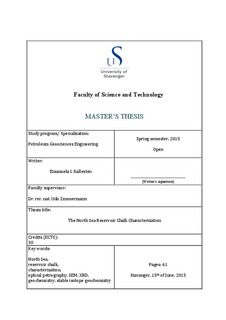| dc.description.abstract | A significant amount of the hydrocarbon production in the North Sea is related to chalk reservoirs. Since 1969, the chalk play remains one of the most important oil sources in Norway. With the initial expected recovery factor 17%, development in technologies and methods contributed to a substantial increase in oil recovery to an approximately 40%. Much of the reserves in place are yet to be extracted, and secondary and tertiary recovery methods need to advance in order to mobilize the remaining hydrocarbons. An essential step in developing new enhanced oil recovery (EOR) methods is the understanding of the reservoir characteristics by thoroughly investigating the parameters influencing the EOR techniques.
This thesis contributes to the EOR research by using an array of analytical methods on core samples directly from one of the North Sea production oil fields, in order to provide a detailed characterization of the reservoir chalk.
Optical petrography shows a very fine, micritic carbonate matrix, with grains represented by various microfossils such as calcispheres, foraminifers, or sponge spicules. The XRD study confirms calcite as most abundant in the whole-rock composition, with quartz as an accessory mineral. The non-carbonate components consist mainly of quartz, but smectite, illite and kaolinite are also present. SEM micrographs indicate that the amount of clay minerals varies, increasing and diversifying upwards; they also show a clear decrease in porosity downwards, with more cementation and higher compaction.
The carbon and oxygen isotopic curves are consistent in throughout the sequence, with few exceptions, but the overall δ 13C and δ 18O are lower than the global isotopic curves expected for this period. The REE patterns are comparable to the typical seawater trends, but the Y/Ho ratios of an average of 36 are much below what is expected if fractionation would take place solely in seawater (above 90). The disturbing factors are interpreted as both clastic sediment input, and secondary fluid flow. The observed chemical differences between the cores do not seem to reflect the flooding status.
Hence, reservoir chalk differs from most of the on-shore chalk (Hjuler and Fabricius, 2009), which compels caution when transferring results from the onshore chalk testing to reservoir chalk. | nb_NO |
